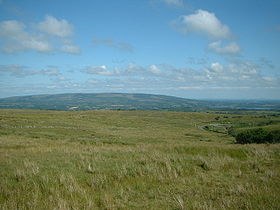Cuilcagh Mountain
| Cuilcagh | |
|---|---|
| Binn Chuilceach | |

View from Cuilcagh
|
|
| Highest point | |
| Elevation | 665 m (2,182 ft) |
| Prominence | 606 m (1,988 ft) |
| Listing | Marilyn, Hewitt |
| Naming | |
| Translation | calcareous/chalky peak (Irish) |
| Pronunciation | Irish: [bʲiːnʲ ˈxɪlʲcəx] |
| Geography | |
| Location | Fermanagh, Northern Ireland & Cavan, Republic of Ireland |
| OSI/OSNI grid | H123280 |
| Topo map |
OSi Discovery 26 |
| Designated | 31 December 1998 |
OSi Discovery 26
Cuilcagh (from Irish: Binn Chuilceach, meaning "chalky peak") is a mountain on the border between County Fermanagh (in Northern Ireland) and County Cavan (in the Republic of Ireland) (once part of the a medieval Kingdom of Breifne). With a height of 665 metres (2,182 ft) it is the highest point in both counties and the 165th highest on the island of Ireland. Water from the southern slope flows underground until it emerges some miles away in the Shannon Pot, the traditional source of the River Shannon.
The name Cuilcagh comes from the Irish Cuilceach, which has been translated as "chalky". However, the mountain is mainly sandstone and shale, covered with bog and heather. "It is possible that the name refers to the limestone rock on the lower northern flanks. Here a number of streams disappear below ground at swallow holes named Cats Hole, Pollawaddy, Pollasumera and Polliniska, all forming part of the Marble Arch cave system. If so, the name would mean 'calcareous' rather than 'chalky'". It has also been called Slieve Cuilcagh in English, 'Slieve' being an anglicisation of Sliabh ("mountain").
In the 1609 Plantation of Ulster, Cuilcagh formed part of lands which were granted to John Sandford of Castle Doe by letters patent dated 7 July 1613 (Pat. 11 James I – LXXI – 38, Quilkagh). It was later sold by Sandford to his wife's uncle Toby Caulfeild, 1st Baron Caulfeild, Master of the Ordnance and Caulfield had the sale confirmed by letters patent of 12 July 1620 (Pat. 19 James I. XI. 45, Quilkagh).
Cuilcagh Mountain has one of the largest expanses of blanket bog in Northern Ireland, on a relatively high elevation upland landscape, bounded by limestone grassland to the north and montane habitats to the south. The blanket bog exhibits a wide range of characteristic vegetation and structural features, with well-developed pool, hummock and lawn features, acid flushes and bog bursts. The bog vegetation is characterised by luxuriant Sphagnum mosses but over most of the site dwarf-shrubs and graminoid herbaceous species dominate. The Cuilcagh area supports a rich assemblage of upland insects, and is one of the most important sites in Ireland for these species. Species recorded include the water beetles Agabus melanarius, Agabus arcticus, Dytiscus lapponicus, Stictotarsus multilineatus, Hydroporus longicornis and Hydroporus morio and the water bugs Glaenocorisa propinqua and Callicorixa wollastoni. Lough Atona is the main locality for these species.
...
Wikipedia

